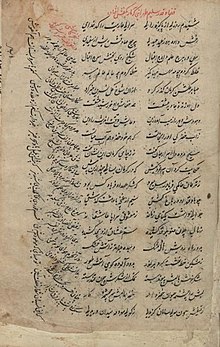Mohammad Qoli Salim Tehrani
Persian poet
You can help expand this article with text translated from the corresponding article in Persian. (January 2020) Click [show] for important translation instructions.
- View a machine-translated version of the Persian article.
- Machine translation, like DeepL or Google Translate, is a useful starting point for translations, but translators must revise errors as necessary and confirm that the translation is accurate, rather than simply copy-pasting machine-translated text into the English Wikipedia.
- Do not translate text that appears unreliable or low-quality. If possible, verify the text with references provided in the foreign-language article.
- You must provide copyright attribution in the edit summary accompanying your translation by providing an interlanguage link to the source of your translation. A model attribution edit summary is
Content in this edit is translated from the existing Persian Wikipedia article at [[:fa:محمدقلی سلیم تهرانی]]; see its history for attribution. - You may also add the template
{{Translated|fa|محمدقلی سلیم تهرانی}}to the talk page. - For more guidance, see Wikipedia:Translation.
Mohammad Qoli Salim Tehrani | |
|---|---|
 al-qada' wa'l-qadar (Handwriting Mathnawi of Predestination) by Mohammad Qoli Salim Tehrani, Malik National Museum of Iran | |
| Born | Mohammad Reza Tarshati Tehrani |
| Died | 1647 Kashmir |
| Years active | 1630-1647 |
| Children | 1 son |
Mohammad Reza Tarshati Tehrani (Persian: محمدرضا طرشتی تهرانی) (died 1647), nicknamed Salim (سلیم) was an Iranian poet and one of the Persian-speaking poets of the Mughal Empire.[1][2][3][4][5]
References
- ^ نظمی تبریزی، علی (۱۹۷۶). دویست سخنور؛ تذکرةالشعرای منظوم و منثور. تابش. ص. ۱۵۱.
- ^ آذر بیگدلی، لطفعلی بیگ (۱۳۳۷). آتشکده آذر. انتشارات علمي. ص. ۱۵.
- ^ سامی, شمسالدین (1311). قاموس الأعلام (به ترکی عثمانی). چهارم. p. ۲۶۱۳.
- ^ نصرآبادی، محمدطاهر (مهر ۱۳۱۷). تذکرة الشعراء. چاپخانه ارمغان. ص. ۲۲۷.
- ^ ذبیحالله صفا (۱۳۸۹). تاریخ ادبیات ایران. چهارم. تهران: انتشارات فردوس. صص. ۴۱۵-۴۱۸. شابک ۹۷۸۹۶۴۳۲۰۴۷۵۴.
- v
- t
- e
Persian literature
Old | |
|---|---|
|
Middle | |
|---|---|
|
Contemporary | |||||||||||||||||||||||||||||
|---|---|---|---|---|---|---|---|---|---|---|---|---|---|---|---|---|---|---|---|---|---|---|---|---|---|---|---|---|---|
| |||||||||||||||||||||||||||||
Contemporary Persian and Classical Persian are the same language, but writers since 1900 are classified as contemporary. At one time, Persian was a common cultural language of much of the non-Arabic Islamic world. Today it is the official language of Iran, Tajikistan and one of the two official languages of Afghanistan.










